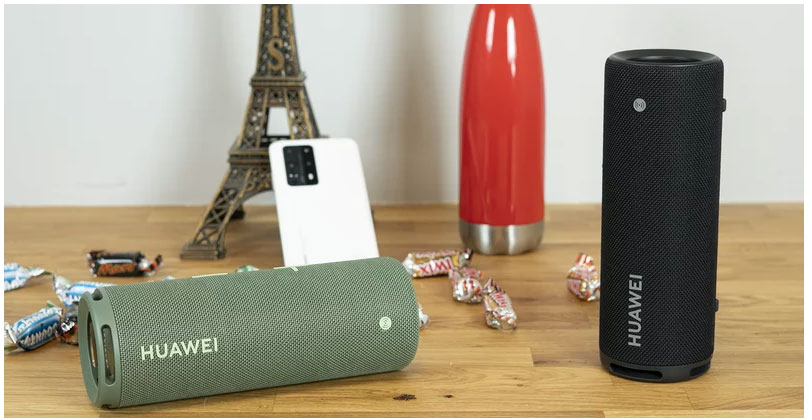Huawei Sound Joy
New fruit of the partnership between Huawei and Devialet, the Sound Joy tackles the market of portable Bluetooth speakers by promising robustness, high quality audio and gargantuan autonomy.
Presentation
For two years now, Huawei and Devialet have been working hand in hand on the Chinese giant's speakers. After a Sound X that was disappointing in many respects, Huawei and the French start-up are now entering the portable Bluetooth speaker market with the new Sound Joy. They hope to nibble away at the indestructible Ultimate Ears and JBL.
The promises of this Sound Joy are numerous: robustness, sound performance worthy of Devialet's reputation, autonomy of 26 hours never seen on this type of product and advanced integration with devices running HarmonyOS 2.0. It remains to be seen if these nice announcements are concrete or just a show.
Manufacturing
In terms of design, the Sound Joy is not original and adopts a cylindrical format very close to what we find in the competition (Boom 3, SRS-XB23, Charge 5...). This proven look is particularly successful on this speaker which combines sobriety and elegance with brio.
The speaker is made of mesh fabric, plastic parts of good quality and does not present any particular point of fragility. Its solidity is confirmed by the IP67 certification indicating an increased resistance to dust and temporary immersion in water. The Sound Joy is therefore perfectly capable of surviving outdoors in bad weather or near a swimming pool.
Connectivity
The Sound Joy can only be used in wireless mode thanks to a Bluetooth 5.2 connection (compatible with AAC and SBC codecs). No analog mini-jack input is indeed available and its USB-C port is exclusively dedicated to charging, contrary to what is indicated on the Huawei website. The speaker also lacks multipoint functionality and therefore requires pairing every time you change sources.
Controls & application
On paper, the Sound Joy looks easy and pleasant enough to handle. In reality, the speaker faces many points of frustration that make it feel like an unfinished product that was released far too early. We encountered so many problems that we asked for a second copy to make sure the first one wasn't defective. No such luck, the second Sound Joy had the same issues.
As controls, the Sound Joy has a series of mechanical buttons on the back, as well as two large volume controls, reminiscent of Ultimate Ears speakers. Only the navigation between tracks is missing, which can be frustrating in use.
The pairing possibilities are multiple on this Sound Joy. In addition to the classic procedure, the speaker integrates an NFC chip on the front for easy pairing with Android and Huawei devices. It's also compatible with quick pairing on Windows 10 and devices running HarmonyOS 2.0. Despite our best efforts, we were unable to trigger this quick pairing with devices running Huawei's OS, as this feature is not available in Europe, a shame! The Sound Joy also needs to be paired every time it is turned on, which is far from convenient.
Like many competing products, it is possible to pair two Sound Joys for stereo sound. To do this, you simply shake the two speakers next to each other, which is easy to do and works quite well. If playing maracas doesn't make you happy, you can also pair two speakers using the button provided. Be sure to deactivate this feature before turning off one of the speakers, otherwise the second one will be blocked with only one stereo channel.
The Sound Joy can also be managed with Huawei's AI Life application. There are indications such as the remaining battery level or options such as the activation of the light ring or different sound profiles. However, the app is quite temperamental and sometimes struggles to detect the speaker.
In addition, we encountered major problems with the recharge. In addition to taking an eternity (count 3 to 4 hours for a full charge), it is not systematically triggered when a USB cable is connected (including the one provided), even if the speaker indicates that it is charging. It's totally "hit or miss" and it's enough to make you tear your hair out!

Autonomy
The Huawei portable speaker offered us about 15 h 30 min of use with a complete load, at a sound level sufficient to "sound" a small room like an office or a bedroom (volume setting at about 40%). A satisfactory score for a speaker of this size, although it is very far from the initial promise of 26 h formulated by the manufacturer.
Let us specify however that the autonomy drops significantly when one wishes to push the volume to benefit from a level of listening more supported (in outside or in a living room, for example). Thus, with 60 % of the maximum volume, the battery was indeed exhausted after 10 h 30 min of continuous reading.
Latency
We measured a latency of 266 ms, which implies a rather frank and very disturbing delay between the sound and the image of a video. The good integration of Bluetooth makes it possible to compensate for this delay on the vast majority of sites and applications such as Netflix, Disney+ or YouTube. No special treatment is given to video games, which are simply impractical with this Sound Joy.
Audio
If Huawei is to be believed, its partnership with Devialet suggested excellent sound performance on the Sound Joy. Despite a relatively good frequency balance, this portable speaker nevertheless suffers from a significant lack of precision and usable power.
It is indeed imperative to remain extremely wise on the sound level to preserve a minimum of listening pleasure, which corresponds globally to 40-50% of the volume according to the contents and is thus appropriate for a listening of proximity in a small room. In these conditions, the proposed sound rendering is quite correct, quite well balanced, while the extension in the bass allows to enjoy a minimum comfortable seating. Even so, the defects of the loudspeaker are already felt, in particular with highs not very detailed, with a slightly piercing and "sparkling" sound. The Sound Joy is also particularly directive and the overall reproduction loses its presence as soon as you are no longer in the direct axis of the speakers, which are placed at the level of the Huawei logo.
As soon as one wishes to benefit from a comfortable listening level and when one plays particularly demanding pieces (with many sources to reproduce, for example), the Sound Joy loses the pedals: the low/midrange becomes very scrambled and drowns out part of the upper frequencies, while the sibilance reaches peaks. To top it all off, the dynamics are very quickly crushed and the different elements clump together, so that it becomes very difficult to dissociate them properly. These are all reasons that instinctively force you to lower the listening level to enjoy your music.
Conclusion
Far from keeping all its promises, the Sound Joy is a sloppy product in many respects. Apart from its very neat and robust design, Huawei's first portable speaker leaves us with a taste of unfinished business, a consequence of the many ergonomic shortcomings of which it is a victim. And it's not its sound performance, barely correct, that saves the day...




